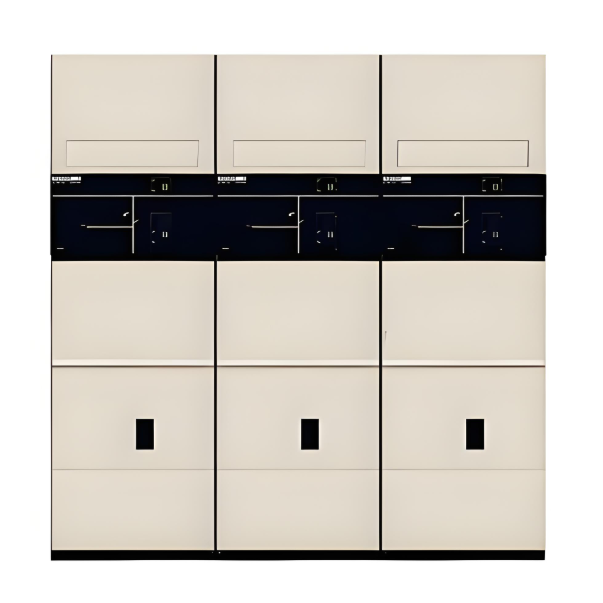
Sumala sa mabilis na pag-unlad sa industriya sa kuryente, ang konsepto ng ekolohiya ng mababang karbon, pampag-iipon, ug pang-ekolohiya gitun-anan nang dako sa disenyo ug pagbuhat sa mga produkto sa kuryente para sa pagdistribute. Ang Ring Main Unit (RMU) usa ka mahimong butang sa kuryente sa mga network sa pagdistribute. Ang seguridad, pang-ekolohiya, operational nga pagkakasiguro, efektibidad sa enerhiya, ug ekonomiya mao ang adunay sigurado nga direksyon sa iyang pag-unlad. Ang tradisyonal nga RMUs kasagaran girepresentarhan sa SF6 gas-insulated RMUs. Tungod sa maayo nga kapabilidad sa pag-eliminado sa ark ni SF6 ug mataas nga insulation performance, sila giwasto gamiton. Apan, ang SF6 nagpakita og greenhouse effect. Tungod sa pagdaghan sa regulasyon sa greenhouse gases, ang pag-develop og environmentally friendly gas-insulated RMUs isip alternatibo sa SF6 naging importante nga direksyon.
Karon, ang mga environmentally friendly gas-insulated RMUs kinahanglan ngadto sa nitrogen-insulated RMUs ug dry air-insulated RMUs. Ang literatura miintroduksyunan kini nga mga opsyon. Kumpara sa insulation capability sa SF6, ang insulation capability sa nitrogen ug dry air ra usa ka tibuok tercio. Tungod kay ani, ang pag-siguro nga ang overall insulation performance sa RMU ug ang iyang internal switches dili maglisud tungod sa pagbaba sa insulation performance sa medium, sama sa pag-maintain sa existing nga cabinet space, labi ka importante. Kini makikita sa disenyo sa internal electrical structure ug insulation structure. Ang maayo nga electrical ug insulation structure design mahimo moganti sa kakulangan sa performance sa insulation medium.
Ang paper niini mikonsentra sa isolating gap sa usa ka 12kV air-insulated RMU. Ito analisa ang nearby electric field distribution ug iyang uniformity, assess ang insulation performance sa lugar niini, ug conduct structural optimization aron mapabag-o ang probability sa discharge ug mapaayo ang insulation performance. Ang studya naghangtod og reference sa insulation design sa similar nga mga produkto.
1 Structure of the Air-Insulated RMU
Ang 3D structural model sa air-insulated RMU nga gitun-anan sa paper niini makita sa Figure 1. Ang main circuit structure sa RMU nagamit og esquema nga nag-combine sa vacuum switch ug three-position switch. Ang layout nagamit og esquema diin ang three-position switch anaa sa busbar side, o mas daghan sabton, ang three-position switch anaa sa upper side sa RMU, apan ang vacuum switch anaa sa lower side pinaagi sa solid-insulated pole.
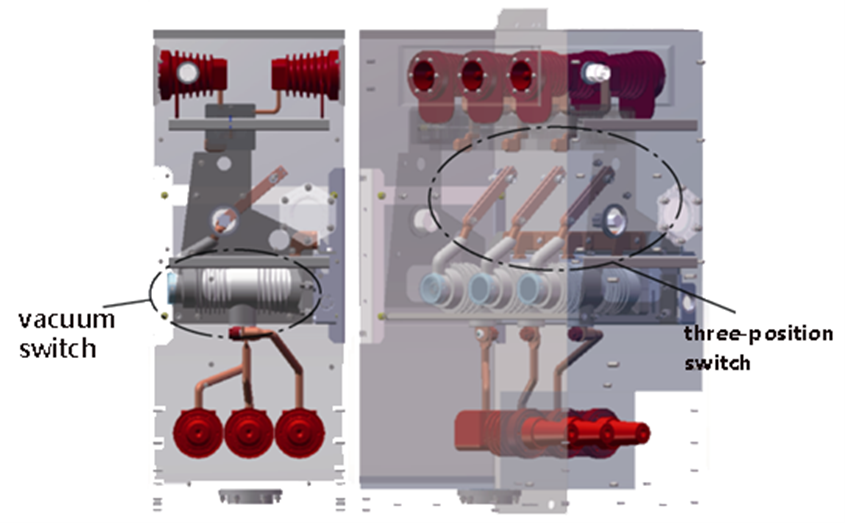
Tungod kay ang vacuum switch nag-encapsulate sa pole, ang iyang exterior insulated pinaagi sa epoxy resin. Ang insulation capability sa epoxy resin wala kaayo superior sa air, kaya mopasabot sa insulation requirements. Giyan, ang connecting busbar sa sealed end sa solid-insulated pole mayda rounded corners, curved designs, ug silicone rubber sealing, nahuman sa partial discharge issues sa lugar niini. Ang insulation clearances sa pagitan sa busbars ug sa ground designed sumala sa relevant insulation requirements ug compliant sa regulations.
Ang isolating blade sa three-position switch depende sa air medium sa insulation. Isip movable connecting component, ang iyang structural design mayda metal parts sama sa pins, springs, disc springs, ug retaining rings aron mapataas ang contact pressure sa pagitan sa isolating contacts. Apan, tungod sa special nga shapes sa kini nga metal parts, sila makapukaw sa highly non-uniform electric field distribution, triggering partial discharge. Kini nagpakita og risk sa breakdown discharge, adversely affecting ang insulation performance sa lugar niini. Tungod kayne, ang electrical structure design diri labi ka importante.
Sumala sa product design requirements, ang isolating gap kinahanglan molihok sa rated short-time power-frequency withstand voltage nga 50kV. Ang minimum electrical clearance sa isolating gap designed as 100mm. Tungod sa komplikado nga structure sa isolating blade, grading shields giatiman sa duha ka gilid sa isolating blade aron mapasabot ang electric field uniformity ug mapabag-o ang occurrence sa partial discharge. Ang 3D model sa three-position switch makita sa Figure 2. Sumala niini, ang paper niini conduct electric field simulation analysis sa isolating gap.
Ang finite element software gisulti sa simulasyon sa electric field sa RMU, analyzing ang electric field intensity distribution sa isolating gap sa given 50kV rated short-time power-frequency withstand voltage. Duha ka scenarios sa electrostatic field simulation gidefine:
- Scenario 1: Busbar side (side with the isolating static contact seat) connected to low potential (0V), line side (side with the isolating blade head) connected to high potential (50kV).
- Scenario 2: Busbar side (side with the isolating static contact seat) connected to high potential (50kV), line side (side with the isolating blade head) connected to low potential (0V).
Ang electric field distributions sa location sa maximum electric field intensity sa isolating gap sa duha ka scenarios gikuhit sa simulasyon. Ang electric field intensity distribution sa isolating blade head sa Scenario 1 makita sa Figure 3, apan ang sa isolating static contact seat sa Scenario 2 makita sa Figure 4. Ang maximum electric field intensity sa Scenario 1 anaa sa end sa grading shield, measuring 7.07 kV/mm. Ang maximum sa Scenario 2 anaa sa chamfer sa isolating static contact seat, measuring 4.90 kV/mm.
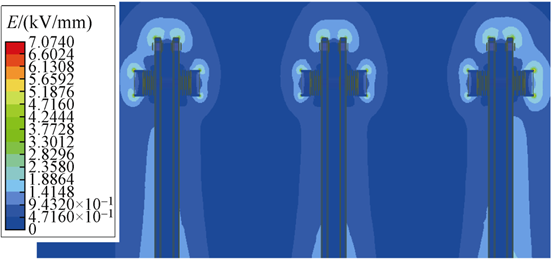
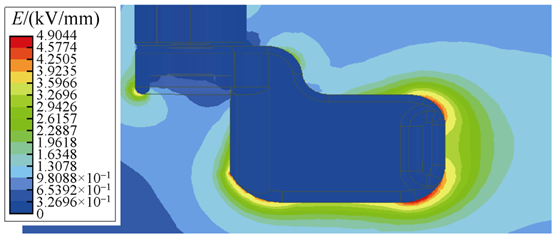
Ang critical breakdown electric field strength sa air sa standard conditions general 3 kV/mm. Figures 3 ug 4 nagpakita nga samtang ang localized areas sa isolating gap gibubo 3 kV/mm, ang field intensity sa uban nga areas wala pa mobo sa threshold, making breakdown discharge unlikely. Apan, ang partial discharge mogahin sa localized positions diin ang field strength gibubo 3 kV/mm.
Tungod kay ang air nag-usab gikan sa dry hangtod sa humid, ang iyang insulation capability nagbaba. Ang critical breakdown electric field strength sa uniform field conditions mobo 3 kV/mm. Giyan, ang extremely non-uniform electric field distribution usab mobo sa air's critical breakdown field strength. Ang duha ka factors nagpadayon sa possibility ug risk sa breakdown. Aron mapabalaka ang impact sa external environmental conditions sa air insulation medium ug mapasabot ang uniformity coefficient sa electric field, ang paper niini naghangtod sa degree sa uniformity sa electric field sa isolating gap ug ang withstand voltage value sa gap. Kini nagpasabot sa basehan aron mapataas ang insulation capability sa isolating gap.
3 Air Insulation Characteristics
3.1 Determination of Electric Field Non-Uniformity Coefficient
Ang perfectly uniform electric fields wala exist sa practice; tanang electric fields non-uniform. Sumala sa non-uniformity coefficient f, ang electric fields giklasi sa duha ka types: slightly non-uniform electric fields kung f ≤ 4; apan extremely non-uniform electric fields kung f > 4. Ang electric field non-uniformity coefficient f determinado pinaagi sa f = E_max / E_avg, diin ang E_max mao ang local maximum electric field strength, obtainable gikan sa simulation results, apan ang E_avg mao ang average electric field strength, calculated as the applied voltage divided by the minimum electrical clearance.
Sumala sa Figure 3, E_max = 7.07 kV/mm apan E_avg = 0.5 kV/mm (50kV / 100mm). Tungod kayne, ang non-uniformity coefficient sa isolating gap f = 14.14 > 4, classifying it as an extremely non-uniform field. Stable partial discharge phenomena mogahin near extremely non-uniform fields. Ang mas taas ang degree sa non-uniformity, ang mas prominent ang partial discharge, apan ang mas dako ang discharge magnitude. Para sa 12kV RMU, ang requirement mao ang total partial discharge sa entire cabinet should be less than 20pC. Reducing the non-uniformity coefficient f beneficial for decreasing partial discharge magnitude.
3.2 Determination of Air Withstand Voltage
Ang non-uniformity coefficient affect the withstand voltage of dry air. When the field is slightly non-uniform, the withstand voltage is:
Formula (1)

Diin:
- U mao ang withstand voltage.
- d mao ang minimum electrical clearance sa pagitan sa electrodes.
- k mao ang reliability factor, typical ranging from 1.2 to 1.5 based on experience.
- E₀ mao ang gas breakdown electric field strength. Sa practice, kini nga value related sa electrode structure. Ang air breakdown field strength varies under different electrode structures and clearances. For comparative analysis in this paper, E₀ = 3 kV/mm is tentatively set.
Sumala sa Formula (1), increasing the minimum electrical clearance d or decreasing the non-uniformity coefficient f can improve the air's withstand voltage. When the field is extremely non-uniform, for electrodes with a minimum clearance d around 100mm, the withstand voltage is determined by:
Formula (2)

Diin U<sub>50%(d)</sub> mao ang lightning impulse 50% breakdown voltage sa electrode sa electrical clearance sa d. Sa extremely non-uniform fields, ang breakdown voltage nagpakita sa significant dispersion ug long discharge time delay, making it highly unstable.
Sa engineering practice, U<sub>50%(d)</sub> determine through multiple lightning impulse tests: ang applied voltage diin ang breakdown occur sa 50% probability define as U<sub>50%(d)</sub>. Kini nga value depend sa product structure ug degree sa field uniformity. Established nga ang lower non-uniformity coefficient result sa smaller breakdown voltage dispersion, higher breakdown voltage, apan consequently, a higher withstand voltage. Tungod kayne, reducing the non-uniformity coefficient f improves the withstand voltage of the isolating gap.
4 Structural Optimization
Para mapasabot ang uniformity sa electric field sa palibot sa isolating blade head ug reduce the non-uniformity coefficient, ang grading shield structure optimized.
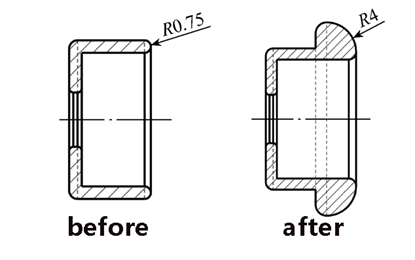
Compared to the original design, the optimized grading shield features a thickened end with a rounded corner design. The fillet radius was increased from 0.75mm to 4mm, enhancing the curvature radius in this area, which benefits achieving more uniform field distribution. The electric field intensity distribution at the optimized isolating blade head is shown in Figure 7. The figure shows the maximum electric field intensity at this location is now 3.66 kV/mm, approximately half of the value before optimization, indicating significant improvement.
Based on the formula f = E_max / E_avg, the electric field non-uniformity coefficient after optimization is 7.32. Compared to the pre-optimization state, this value is reduced to about half. The uniformity of the electric field near the isolating blade head has also significantly improved, demonstrating the reasonableness of the structural optimization.
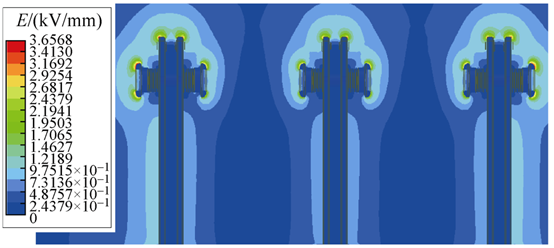
The optimized grading shield structure indeed reduces the risk of breakdown discharge across the isolating gap. However, the electric field across the gap remains extremely non-uniform, and its withstand voltage is still determined by U<sub>50%(d)</sub>. The extent to which the withstand voltage can be increased needs to be determined through subsequent field tests.
5 Conclusion
Through electric field analysis of the isolating gap in a 12kV air-insulated RMU, this paper reached the following conclusions:
- Due to the inferior insulation capability of air compared to SF6, using air for insulation in the three-position switch within RMUs requires improving electric field distribution to enhance insulation capability.
- Due to the structural complexity of moving parts (the isolating blade) within the three-position switch of air-insulated RMUs, the electric field intensity distribution at localized positions can become highly non-uniform. To reduce non-uniformity, grading shields can be added on both sides of the isolating blade to shield the electric field intensity near the ends of the blade connectors, shifting the maximum local field intensity to the ends of the grading shields. This paper increased the curvature radius of the grading shield end from 0.75mm to 4mm. This reduced both the maximum local electric field intensity and the non-uniformity coefficient to approximately half their original values, achieving the desired effect.
- The degree of electric field uniformity, or the non-uniformity coefficient, significantly impacts partial discharge and breakdown discharge. Extremely non-uniform fields easily lead to stable partial discharge (corona discharge). For both slightly and extremely non-uniform fields, a higher non-uniformity coefficient corresponds to a lower withstand voltage between the two electrodes.





























